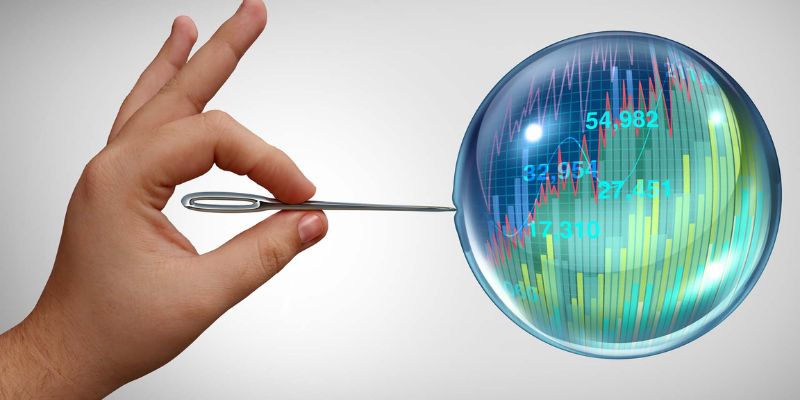How to identify a stock market bubble isn’t a walk in the park. You smell the buzz; everyone talks about soaring stocks, but that itch in your mind won’t go away — are we in a bubble? Knowing how it looks before it pops is vital. I’ll show you how to spot the telltale signs. Think of it like bubble gum. It grows shiny, stretches thin, and right when it seems it can’t get any bigger, it bursts. That’s when those who saw it coming breathe easy. So, let’s dive in and peel back the layers of this financial phenomenon with simple know-how that even your neighbor could grasp. And remember, what goes up must come down — except for those prepared for the fall.
Understanding the Fundamentals of Stock Market Valuations
Evaluating PE Ratios and Other Valuation Metrics
Let’s chat about PE ratios. They are like scores that tell us if stocks are pricey. A high PE means a stock costs more than its earnings show. Think of it like this: if a toy’s price feels too high for what it is, you’d call it over-priced. Stocks are similar.
PE stands for price-to-earnings. It’s a simple math thing. You divide a company’s stock price by its earnings per share. If the PE is way higher than usual, watch out. It might suggest a bubble is growing.
But don’t stop there. Check other facts, too. Look at how people feel about the stocks. See if they’re just excited or chasing a dream without solid numbers to back it up. This mix of facts and feels gives you a clearer picture.
Recognizing Overvalued Stocks and Price Growth Trends
How can you tell if a stock’s too high? Look past the hype. See if stocks grew too fast in a short time. It’s like when a balloon gets too much air too quick, it’s bound to pop. Not good for balloons or your wallet.
Quick growth can happen with tech companies a lot. Think back to the dot-com bust. Those stocks rocketed up before tumbling down. We noticed too late they weren’t worth the sky-high prices. It’s a history lesson in stocks — don’t ignore crazy price jumps.
And it’s not just tech. Any stock can leap too high. Use history as your guide. Compare past bubbles, like the 2008 crash. Ask yourself: does this look familiar?
But remember, not all fast-growing stocks are bad. Some grow fast but have the earnings to back it up. The trick is to balance growing prices with real, solid earnings. If the two don’t match up, you might be staring at a bubble.
Watch out for folks eager to buy, no matter the cost. This market euphoria can blind investors. They forget the basics and just want in on the action. This “irrational exuberance” can fuel a bubble.
Tulip mania, that flower frenzy from way back, is another example. People paid crazy money for bulbs. But in the end, they were just flowers. That didn’t end well for them. Keep that in mind when the next hot trend comes along.
So, to spot a bubble, use your PE tools. Look for stocks too high for their own good. Watch for prices sprinting up with no reason. And check if everyone’s buying just because it’s popular. That’s your cue a bubble might be near.
Remember, picking out a stock market bubble isn’t easy. Others might not see what you see. But stay sharp and learn your market history. It’s your guidebook for noticing those big bubble warning signs. And finding them early can save you a lot of trouble and money when the bubble bursts.

The Psychology Behind Market Bubbles
Identifying Investor Irrational Exuberance
Let’s talk about bubbles. No, not the soapy ones – the stock market kind. You’ve heard people say, “This is too good to be true,” right? Well, sometimes the stock market feels that way. Folks get too excited, throwing money into stocks without thinking. That’s what we call “investor irrational exuberance.” It’s like a party where no one wants to leave, but the music’s got to stop sometime.
Now, to spot this festive frenzy, look at the stock valuation metrics. When the PE ratio of a company flies high, way above its average, it means the party’s in full swing. Think of PE ratios as the DJ of the stock market – they clue you in on the market mood.
Another sign is when everyone is talking about the same stocks. Suppose your neighbor who never cared about stocks starts giving you hot stock tips. That’s a sign folks are getting too hyped. This euphoria can blind people to risks. Suddenly, it feels like prices will climb forever. But like a bike going downhill with no brakes, it can end with a crash.
Analyzing Historical Market Bubbles and Their Lessons
Looking back helps us spot these dangerous dances in the future. Take the dot-com bubble, for example. Back in the late ’90s, if a company had “.com” in its name, people threw money at it. Didn’t matter what they did. Some of these companies didn’t make any profit, ever. But, boy, their stock prices were on a rocket to the moon. Spoiler: the rocket crashed.
And who could forget the 2008 financial crisis? It’s like the ghost story of the financial world. Home prices skyrocketed, and banks gave loans to anyone with a pulse. When people couldn’t pay up, it all went down the drain, fast.
Every bubble leaves clues – like a trail of breadcrumbs. The 17th-century tulip mania? Flowers sold for more than houses. Crazy, right? It’s easy to see it now, but back then, people just saw the chance to get rich quick.
From these stories, we’ve learned that when things feel too easy, like money growing on trees, a nasty fall might come. The key is to spot the merry-making before the music stops. Possible? Yes. Easy? Not at all.
Now, with these tales in mind, you can watch for signs today. Is the market going up too fast? Are folks babbling about stocks they know nothing about? Is everyone and their dog investing in tech because “it’s the future”?
Remember, bubbles don’t whisper warnings; they pop loud and clear. Spot the signs early, and you can tap out of the dance before the stampede to the exit starts. Keep your eyes peeled on those stock charts, and stay grounded when others are floating away with the music.

Monitoring Warning Signs of a Bubble
Assessing Excessive Market Speculation and IPO Activities
Let’s dive into signs of a stock market bubble. Think of a market bubble like a big, shiny balloon. It’s exciting to see it grow bigger. But if it gets too big, it pops! We can watch for the same thing in the stock market. Look out for times when it seems like everyone is buying stocks, not to own a piece of a company, but just to sell them later for a quick buck. This often leads to unsustainable stock price growth.
One sign of trouble is when new companies start to sell shares, which we call an IPO, and their stock prices shoot up fast. If this happens a lot, it can be like too much air going into our balloon. It’s fun at first, but risky. New companies should grow their business before their stock prices get too high. When prices jump up without real growth, we should be careful.
Keeping an Eye on Insider Selling and Margin Debt Levels
Another sign is looking at what the bosses of these companies do – do they hold their shares or sell them? If you see the bosses selling a lot of their own stock, it might mean they think the stock’s price is higher than it should be. They’re cashing out while the going is good, and that can be a warning for you too.
Then there’s margin debt. Imagine you get money from a friend to buy something. You have to pay it back later, maybe more if the thing’s value drops. That’s like margin debt, but in the stock market. If lots of people borrow money to buy stocks, it can push stock prices up. But if they can’t pay back the loans, stock prices can fall just as fast. When you see high levels of margin debt, it can mean there’s too much risky money in the market, and that’s a big red flag.
Remember, picking out these signs isn’t just guesswork. We’re building up from history, looking at past bubbles and spotting the same patterns. It’s like connecting the dots. The dot-com crash and the 2008 financial crisis were tough times that taught us lessons. Learning from these, we know better what to look for now to spot trouble ahead.
Stay sharp and keep watching for these signs. It can help you avoid getting caught when the market overheats and that bubble pops. By spotting these signs and being careful, you can protect your money, and that’s a good feeling.

Preparing for the Aftermath of a Bursting Bubble
Analyzing the Impact of Central Bank Policies on Asset Bubbles
Central banks shape the flow of money. Their choices can inflate bubbles. Let’s dive into how. They cut interest rates? It’s easier to borrow and spend. This can pump up asset prices, more than they’re really worth. That’s a seed for a bubble.
But why does this matter to you, the investor? If you know what the central bank does, you can guess where the market might go. If they keep rates low, watch out. It could mean a bubble is boiling up. When they start to hike rates? The bubble might burst. Assets that shot up in price can fall hard. It pays to keep an eye on what central banks say and do.
Understanding their policies helps you see warnings of a market bubble. You’ll know if it’s smart to play it safe or seek chances to earn money. But remember, central banks can change gears fast. Stay updated with their latest moves. You could save money or spot new openings to grow it.
Exploring the Consequences and Historical Precedents of Bubble Bursts
Now, let’s look back at history — it has lessons for us. Examples like the dot-com crash or the 2008 crisis show us how bad a bubble burst can be. Folks lose jobs, savings take a hit, and it can take years to heal.
Why does this old news matter? Because history often repeats itself. When you see signs like too-high stock prices, crazy buying, or too much loaning, a bubble might be near its pop. Looking back at past bursts helps you see these signs today. They’re like a code to help you figure what could happen next.
The dot-com bubble is a classic. Tech stocks went sky-high. People spent money on hopes, not facts. Then, it all came crashing down. Stocks that once had stars in their eyes lost most of their shine. Many investors took big losses. And the 2008 crisis? It showed us that even big names aren’t safe when a bubble bursts.
Learn from these stories. They teach us to be careful and look for signs that a bubble might burst. Recognize when things don’t make sense. Is everyone talking about one stock? That can be a warning. Are house prices jumping too fast? Another red flag. These clues can help you protect your cash and even find good deals when prices fall.
Both these moments in history, the dot-com bubble and the 2008 financial crisis, give us a map. They show us how bubbles can swell and pop. Keep these tales close. They can help you read the market and maybe even save you from a fall.
Reacting the right way when a bubble pops can be just as important as seeing it come. When things go down, it’s not just about the money you could lose, but also about chances that might show up. Smart moves can turn a tough time into a step up for your investments.
In this post, we’ve broken down key concepts like stock market valuations, including PE ratios, and what they say about prices. We’ve seen how to spot an overvalued stock. Next, we dove into market bubbles, checking out why investors get too hyped and the big lessons from past bubbles. We also covered the warning signs, from too many new companies to insiders who sell their shares and rising debt. Lastly, we checked what happens when a bubble bursts and how central banks play a role. Keep an eye on these signs and always think ahead. That’s how you stay smart about investing. Remember, markets can soar and then suddenly fall. Knowing this helps you decide wisely, so you’re ready for anything the market does.
Q&A :
What Are the Classic Signs of a Stock Market Bubble?
Identifying a stock market bubble often involves looking for key characteristics that emerge when market prices are inflated beyond their intrinsic values. Common signs include unusually high price-to-earnings ratios, speculative investor behavior, a rapid increase in stock prices, and excessive leverage by investors and companies. Media and public enthusiasm can also play a significant role, as can the presence of new market entrants drawn by fear of missing out on gains.
How Can You Tell if a Stock is Overvalued?
There are several metrics to evaluate whether a stock might be overvalued, potentially indicating a bubble. These include but are not limited to, a high price-to-earnings (P/E) ratio compared to industry standards, a high price-to-book (P/B) ratio, and an elevated price-to-sales (P/S) ratio. Additionally, investors should also consider the company’s growth prospects, competitive position, and overall market conditions. If a stock’s price seems to be rising without a corresponding increase in fundamental value, it might be overvalued.
What Historical Examples Exist of Stock Market Bubbles?
Historical examples provide insight into the patterns and outcomes of stock market bubbles. Some noteworthy cases are the Tulip Mania of the 17th century, the South Sea Bubble of 1720, the Wall Street Crash of 1929, the Dot-com Bubble of the late 1990s, and the Housing Market Bubble that contributed to the financial crisis of 2008. Each of these events was marked by rapid increases in asset prices followed by sudden and often catastrophic losses.
How Does Investor Psychology Contribute to a Market Bubble?
Investor psychology plays a critical role in the formation of market bubbles. Factors such as greed, the fear of missing out (FOMO), herd behavior, and overconfidence can drive investors to buy into an asset class despite signs of overvaluation. The collective belief that one can sell overpriced assets to someone else before the market corrects, known as the greater fool theory, often exacerbates bubble conditions.
What Strategies Can Investors Use to Avoid Getting Caught in a Stock Market Bubble?
To avoid the fallout from a bubble, investors may implement several strategies. Diversifying their portfolio can help mitigate risk, as can staying informed about market trends and thinking critically about hype. Investors should focus on fundamental analysis rather than just technical signals or market sentiment. Setting strict buy and sell rules, avoiding the use of excessive leverage, and maintaining a long-term investment horizon are also prudent approaches to safeguarding one’s investments.



